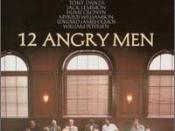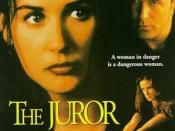12 Angry Men (1957): Persuasive events and scenes Essay
Topic: At the beginning of the film the jurors vote 11 to 1 to convict the defendant and sentence him to the death penalty. What are the events that lead the jurors to change their minds and set the defendant free? Describe the process, including why specific characters originally vote the way they do and what this reveals about the characters.
The deliberations process between the twelve 'angry' men is a long and tedious battle which causes great tension and reveals the true characters of each juror. While initially the jurors voted eleven to one to convict the defendant, common logic and justice prevail to free the defendant. The 'pack' decide this without any doubts and are amazed that one juror does not conform. This brings about a comprehensive breakdown of the facts and exposes human frailties and the power of 'peer-pressure'.
The events that lead the jurors to alter their opinions and set the defendant free are based around various scenarios. These include the young mans inability to account for where he was on the night in question. The emotional stress of the defendant was provided as reasoning - it was impossible for him to remember the movie title but no proof of guilt.
Secondly, the testimony of the witness (old man) was in question as he had trouble reaching the witness chair due to a stroke. Therefore there was an improbability of reaching the door to see the perpetrator escaping the crime as given in evidence.
Defendant's use of switch blade was found to be unlikely - the proper use of it and its common availability uncovered even though it was claimed unique.
Lastly were the facts discovered through analysis of the witness, namely the woman who probably wore glasses. She was deemed to be of questionable sight therefore an improbable witness to the crime due to number of inconsistencies. These included not having glasses at the time, being a considerable distance away, the darkness and viewing through an empty train carriage.
The characters engage in heated arguments but gradually change their opinions.
Standing alone and with conviction is Juror #8, Davis. Davis is unsure that the defendant is guilty and believes there's reasonable doubt. He refuses to send the boy to die without discussion. Davis is a sceptic, weighing the facts up. He believes that there are inconsistencies in the evidence.
There develops a rivalry between him and Juror #4 who is equally analytical but lacks emotion and integrity shown by Davis. Juror #4 believes that the boy's alibi of being at the movies was flimsy and "slums are breeding grounds for criminals". He states that they are "potential menaces to society". He believes the defendant should be able to recount the information about the movie that he could not recall.
Juror #7 shows disinterest and an eagerness to finish the case quickly so he can attend his baseball game. Throughout the film he's arrogant and rude making offensive wisecracks. He bases his original vote on the defendant's tainted history and previous criminal offences. He's a racist and this is evident through his interaction with immigrant
Juror #11. The immigrant juror has integrity and believes that "one should stick up for what they believe is right."
Juror #3 has a volatile personality he's a powerful influential businessman he becomes irritated by the events that Davis has initiated. Juror #3's arguments although substantiated initially were later fractured because facts which he assumed didn't quite add up. He is disillusioned with youth and his animosity to the defendant is a reflection of his ruined relationship with his estranged son. He is accused of being a "self appointed public avenger" by Davis.
The events that lead the jurors to change their minds and set the defendant free are led initially by Davis. He provides a building block for further analysis of the case and reinforces throughout the film the concept of "reasonable doubt". Davis provides a reenactment of the crime and the explains the witnesses account of it. He finds many flaws and inaccuracies and having presented these to his fellow jurors one by one they fall like flies. Gradually through the additional key information provided by fellow jurors mainly McCradle they become convinced of the defendants innocence. The previously mentioned events led to these jurors changing their minds.
The last to succumb is Juror #3 who breaks down claiming "rotten kids you work all your lifeâ¦" He finally realizes that his bias towards the defendant is due to his own deep personal grudge. This final resolution shows that justice is served!
Bibliography:
No resources used.





